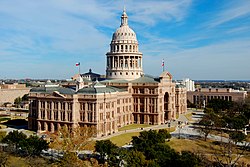Texas State Capitol
|
Texas State Capitol
|
|

At the time of its construction, the capitol building was billed as "The Seventh Largest Building in the World."
|
|
| Location | Congress and 11th Sts Austin, Texas, U.S. |
|---|---|
| Coordinates | 30°16′29″N 97°44′26″W / 30.27472°N 97.74056°WCoordinates: 30°16′29″N 97°44′26″W / 30.27472°N 97.74056°W |
| Area | 51.4 acres (20.8 ha) |
| Built | 1885 |
| Architect | Elijah E. Myers |
| Architectural style | Italian Renaissance Revival |
| NRHP Reference # | 70000770 |
| RTHL # | 14150 |
| TSAL # | 641 |
| Significant dates | |
| Added to NRHP | June 22, 1970 |
| Designated NHL | June 23, 1986 |
| Designated RTHL | 1964 |
| Designated TSAL | May 28, 1981 |
The Texas State Capitol, completed in 1888 in Downtown Austin, contains the offices and chambers of the Texas Legislature and the Office of the Governor. Designed in 1881 by architect Elijah E. Myers, it was constructed from 1882 to 1888 under the direction of civil engineer Reuben Lindsay Walker. A $75 million underground extension was completed in 1993. The building was added to the National Register of Historic Places in 1970 and recognized as a National Historic Landmark in 1986. The Texas State Capitol is 302.64 feet (92.24 m) tall, making it the sixth tallest state capitol and one of several taller than the United States Capitol in Washington, D.C.
The current Texas State Capitol is the third building to serve that purpose. The second Texas capitol was built in 1853, on the same site as the present capitol in Austin; it was destroyed in the great capitol fire of 1881, but plans had already been made to replace it with a new, much larger structure.
Construction of the Italian Renaissance Revival–style capitol was funded by an article of the state constitution, adopted on February 15, 1876, which authorized the sale of public lands for the purpose. In one of the largest barter transactions of recorded history, the builders of the capitol (John V. Farwell and Charles B. Farwell), known as the Capitol Syndicate, were paid with more than three-million acres (12,000 km²) of public land in the "Panhandle" region of Texas; this tract later became the largest cattle ranch in the world, the XIT Ranch. The value of the land, combined with expenses, added to a total cost of $3.7 million for the original building. It was constructed largely by convicts or migrant workers, as many as a thousand at a time. The building has been renovated several times, with central air conditioning installed in 1955 and the most recent refurbishments completed in 1997.
...
Wikipedia
